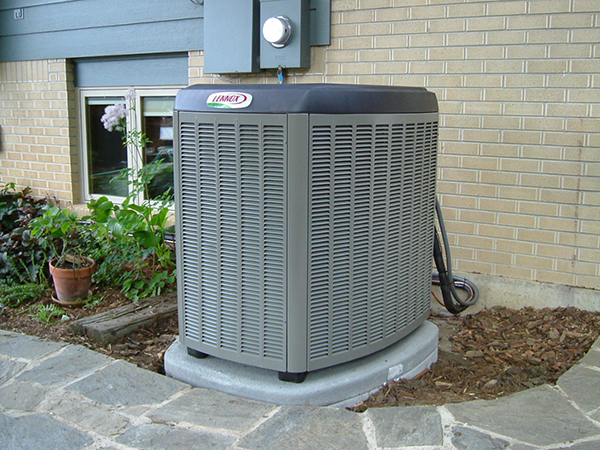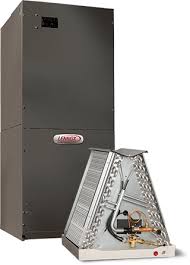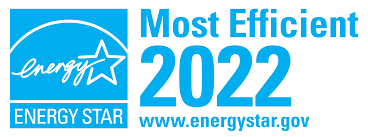What Is a “Ton of Cooling” in Your AC Unit?
 If you’re getting quotes for a new central AC or heat pump system for your home, there are many things to consider when deciding on the unit to cool your home. In addition to things such as efficiency and sound ratings, another important one is the unit’s size, or cooling capacity. For residential central AC and heat pumps, cooling capacity is normally discussed in terms of how many “tons of cooling” a system can supply.
If you’re getting quotes for a new central AC or heat pump system for your home, there are many things to consider when deciding on the unit to cool your home. In addition to things such as efficiency and sound ratings, another important one is the unit’s size, or cooling capacity. For residential central AC and heat pumps, cooling capacity is normally discussed in terms of how many “tons of cooling” a system can supply.
In this article, we’ll take a closer look at where the phrase “tons of cooling” came from and how it applies to the conversations we have with homeowners about central cooling systems.
The Meaning of a Ton
The basis of understanding tons of cooling in the world of AC units is rooted in having a general grasp of the acronym BTUs, short for British Thermal Units. The commonly accepted definition of a BTU is as follows: a measure of the amount of heat required to raise the temperature of one pound of water one degree F. In cooling applications, BTUs are used to describe the amount of heat that must be removed to lower the temperature of that pound of water one degree F. BTUs are a very common, standard term and frame of reference that’s used in many applications involving both cooling and heating system sizing and performance.
- Simply put, a ton of cooling is equal to 12,000 BTUs. More on that in a moment.
A Ton of Cooling: Origin of the Term
 The phrase “a ton of cooling” stems from the Ton Of Refrigeration unit (TOR or TR), which was coined in the 1880s and used mainly in North America during the period of transition from using stored natural ice for cooling purposes to the development of mechanical refrigeration systems. Without diving into the math/physics details of it, a TOR represented the consumption of one ton of ice per day. The origin of the term is similar in respects to the origins of “horsepower” and “candlepower,” which were also considered to be intuitive units of measurement – in these cases for people living through the transition from horses to motorized transport, and from flame-based to electric lighting.
The phrase “a ton of cooling” stems from the Ton Of Refrigeration unit (TOR or TR), which was coined in the 1880s and used mainly in North America during the period of transition from using stored natural ice for cooling purposes to the development of mechanical refrigeration systems. Without diving into the math/physics details of it, a TOR represented the consumption of one ton of ice per day. The origin of the term is similar in respects to the origins of “horsepower” and “candlepower,” which were also considered to be intuitive units of measurement – in these cases for people living through the transition from horses to motorized transport, and from flame-based to electric lighting.
The effects of the Industrial Revolution continued to be felt in our jargon, even in the late 1800s and beyond. In 1903, with the beginning of industry associations in our country, a ton of cooling became standardized to mean 12,000 BTUs for the purpose of equipment specifications.
Tens of Thousands of BTUs For Central Air Conditioning for Your Home
 When sizing a new central air conditioner or heat pump, your HVAC contractor runs a detailed calculation to determine the cooling output needed from the system in order to keep your home comfortable when it’s very hot outside. This calculation provides the cooling load of the home in “BTUs per hour.” In typical residential applications this load number falls in the range between 18,000 and 60,000 BTUs per hour; the higher the number, the larger the system you’ll need.
When sizing a new central air conditioner or heat pump, your HVAC contractor runs a detailed calculation to determine the cooling output needed from the system in order to keep your home comfortable when it’s very hot outside. This calculation provides the cooling load of the home in “BTUs per hour.” In typical residential applications this load number falls in the range between 18,000 and 60,000 BTUs per hour; the higher the number, the larger the system you’ll need.
Now, this is where tons of cooling comes back into play, and our apologies for the mental gymnastics (we’re just the messenger!). For example, if the cooling load provided by your contractor dictates that 36,000 BTUs of cooling is needed, divide that number by 12,000 in order to determine the size in tons of the equipment needed – in this case a 3 ton unit (36,000 BTUs divided by 12,000 BTUs/ton = 3 tons), which is common in many mid-size homes. Our team at Save Home Heat sees a wide variety of homes each year, and we install many systems that are sized between 2 and 5 tons.
We’re glad to report that for ductless mini-split air conditioners and heat pumps, the conversion of tons is not part of the lingo; we simply talk in terms of BTUs. Please look for a separate blog from our team about sizing ductless systems, also this month!
Common Tonnage Ratings and Other Central AC Considerations
 Central AC units used in typical home applications range from 1½ tons (18,000 BTUs of cooling) to 5 tons (60,000 BTUs) for a single system. AC systems with cooling capacities larger than 5 tons are considered to be light commercial equipment and are not compatible with residential furnaces. Residential central AC systems are normally available in ½ ton increments, except for the largest sizes, with most manufacturers offering 1½, 2, 2½, 3, 3½, 4, and 5 ton size units.
Central AC units used in typical home applications range from 1½ tons (18,000 BTUs of cooling) to 5 tons (60,000 BTUs) for a single system. AC systems with cooling capacities larger than 5 tons are considered to be light commercial equipment and are not compatible with residential furnaces. Residential central AC systems are normally available in ½ ton increments, except for the largest sizes, with most manufacturers offering 1½, 2, 2½, 3, 3½, 4, and 5 ton size units.
In some of the larger homes that we work in, say in the 5,000 square foot range and higher, we occasionally see more than one separate forced air heating and cooling system, serving different areas of the home. Those parts of the home are addressed independently when it comes to sizing cooling and heating equipment. The multiple-system approach in larger homes helps maintain comfort levels and also assists in ensuring reliable, efficient operation.
Ensuring Your Cooling Load is Accurate
 There is no rule of thumb when it comes to matching the right size AC unit to your home. It’s not as simple as considering square footage or the number of rooms that need cooling – there are many different factors that play an important role. In order to ensure efficient and comfortable performance, accurate equipment sizing produced by an accurate cooling load calculation is critical. This is one of many reasons why you should consult an experienced, dependable HVAC pro during the process of getting quotes and deciding what to cooling system to purchase. For sizing residential AC systems, our team at Save Home Heat Company uses the Manual J program – the current industry standard – for determining the correct size central AC units for our customers in the Denver-Boulder metro area.
There is no rule of thumb when it comes to matching the right size AC unit to your home. It’s not as simple as considering square footage or the number of rooms that need cooling – there are many different factors that play an important role. In order to ensure efficient and comfortable performance, accurate equipment sizing produced by an accurate cooling load calculation is critical. This is one of many reasons why you should consult an experienced, dependable HVAC pro during the process of getting quotes and deciding what to cooling system to purchase. For sizing residential AC systems, our team at Save Home Heat Company uses the Manual J program – the current industry standard – for determining the correct size central AC units for our customers in the Denver-Boulder metro area.
We’ll be visiting the Manual J calculation in more detail in an upcoming blog, but suffice to say that it takes more than just a few factors into account, many of which our customers may not have considered. Our comfort advisers spend a considerable amount of time with the tape measure and entering a variety of numbers into the Manual J when we come out to provide a free install quote.
Other Important Central AC Install Factors
In addition to accurate equipment sizing, while working up an estimate for a new central AC system our comfort advisors at Save Home Heat also consider factors such as making sure the components in your current system are compatible with the recommended cooling unit; for instance, the existing furnace blower, your home’s return-air ducting, and the furnace air filter. Does the furnace move enough air to do the job right? Are there airflow issues to upper-level rooms or areas far from the furnace? Does the current furnace filter pose potential issues for good AC performance? No matter how simple or complex your situation may seem, an experienced HVAC contractor may be able to spot potential issues or ways to improve system performance and your comfort, before any work is done.


Friendly, Low-Pressure Expertise in Denver-Boulder
For Denver-Boulder area homeowners who want to better understand the tons of cooling required for their homes while obtaining quotes to install a new central AC or heat pump system – or who have any questions at all related to cooling their homes – our AC experts at Save Home Heat Company have the experience and knowledge that you’re looking for.
Please contact me to discuss a new cooling system for my home!
Tags: Cooling



